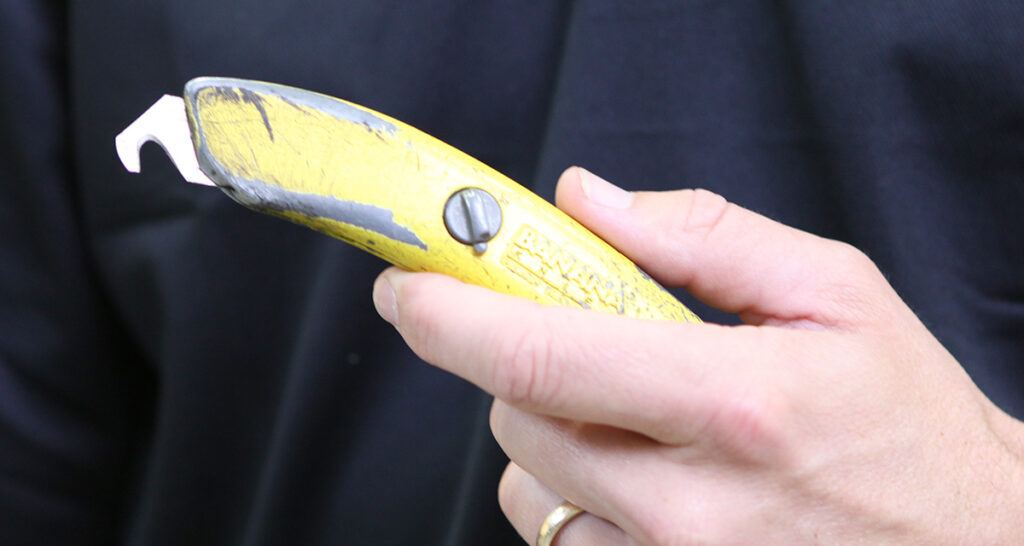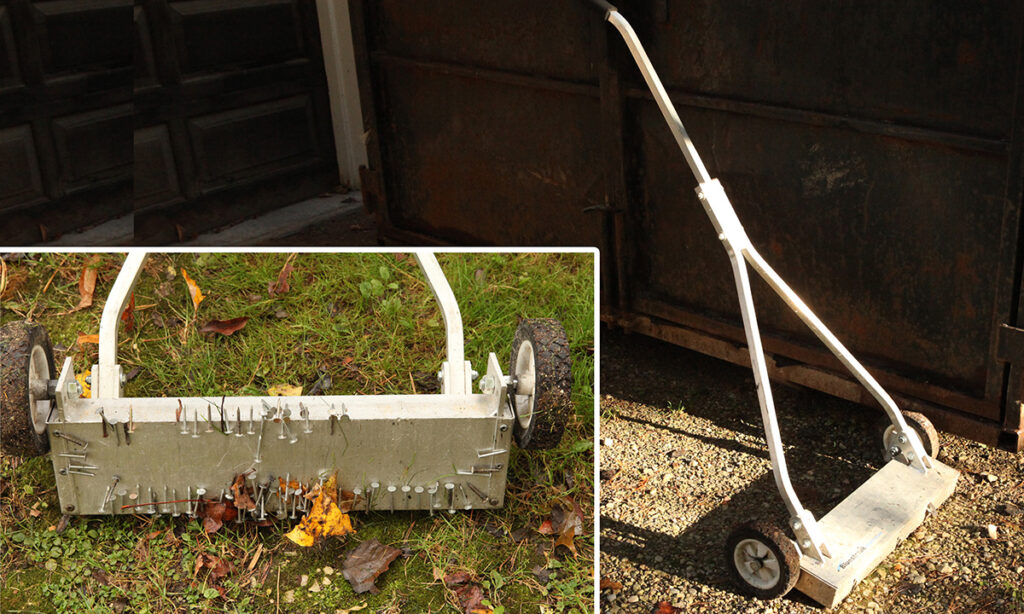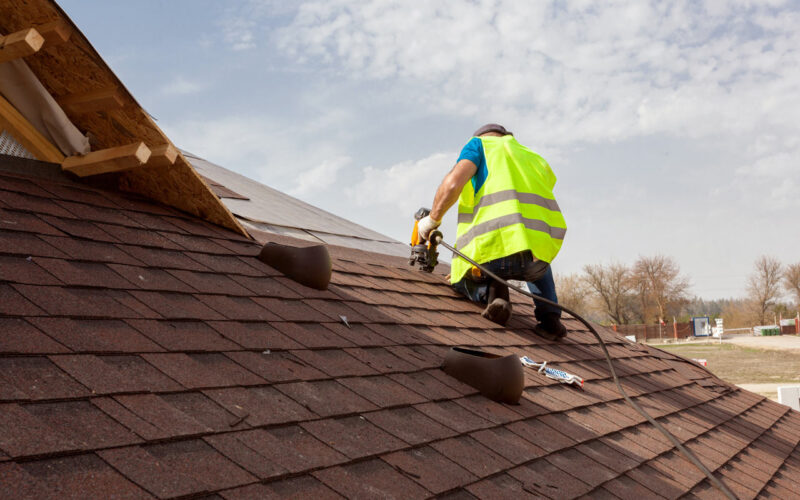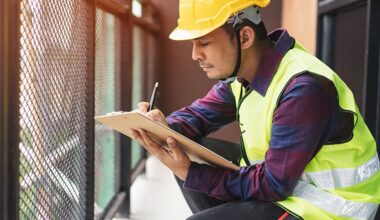Whether you’re a professional roofer or a do-it-yourself homeowner, one thing is certain: you’re only as good as your supplies. But how do you know which shingle roofing tools are a must-have?
That’s where we can help. Continue reading to learn about the essential shingle roofing equipment and tools that every handyman or DIY homeowner should have!
Knowing what roofing equipment and tools you’ll need to make a repair is the first step in the preparation for your roofing business or your DIY repairs. Aside from a ladder, a proper roofing toolkit necessitates the use of specialized equipment. Attempting to repair your roof without proper preparation can be unpleasant or even dangerous. On the other hand, being well prepared and outfitted with the proper roofing tools will keep you on top of your game—and roof.
In our roofing tools list, we have compiled 25+ essential shingle roofing equipment and tools that you’ll need.
In-Depth Look at General Shingle Roofing Equipment and Tools
You most likely already have some of this shingle general roofing equipment and tools that will help you install your new roof.
#1. Roofing hammers or hatchets and nail guns
Most roofers will use nail guns to apply shingles and perform other nailing tasks. Although nail gun safety is an issue, most roofers find that nail guns are faster than hammers. However, many roofers still prefer to use roofing hammers or hatchets. If you decide to use nail guns, you’ll still need a roofing hammer for other nailing tasks, or when holding a nail gun is more trouble than it’s worth.
#2. Stapler Hammer Tacker
Depending on your building code requirements, felt underlayment can be installed with staples or cap nails. If you want to use staples, you’ll need a staple gun. If you’re going to use air nail guns, you should also use an air staple gun. There are even nail and staple guns that are two in one.
When installing felt underlayment, you must also install 1-inch plastic or metal caps. In the event of a tear, these caps keep water from getting beneath the underlayment.
#3. Air Compressor
If you decide to use pneumatic nail guns, you will also need a roofing air compressor to keep the pressure in your tools constant. You might be tempted to buy a nailer-compressor combination tool that doesn’t require an air compressor. These tools, however, do not maintain enough pressure to complete a roofing job. Furthermore, the air cartridges are costly. Keep in mind that any delays on the job site will cost you labor time and missed opportunities for additional work. It is far more convenient to keep a compressor on hand at all times.
As your company grows, you may find yourself operating multiple nail guns at the same time. If this is the case, you may require a reserve air tank, also known as a “pig” air tank, to supply the extra air required to keep all of the nailers running at the same time. Purchasing a reserve tank may be less expensive than purchasing a new air compressor.
#4. A Shingle Cutter: Either a Roofing Blade or a Utility Knife will suffice.

Roofers require utility knives or roofing hook blades for a variety of tasks, including shingle cutting. When installing 3-tab shingles, the shingles must be cut in sections to form hip and ridge shingles. Whatever shingle you choose, you’ll also need to cut a roof underlayment and an ice and water protector. A utility knife is adequate for the job, but a roofing knife is more specialized and makes your job easier. When working with thicker material, such as shingles, roofing blades have special hooks near the edge to help you control the cut.
#5. Pry Bar, Scoop Shovel, or Roofing Shovel
Scoop shovels are large, deep shovels with no point, as opposed to flat, pointed digging shovels. A scoop shovel can be used by a roofer to move loose shingles into a dumpster.
A scoop shovel maybe your best option at first because it is inexpensive and will do the job. However, roofing shovels or tear-off shovels should also be considered. These specialized tools are the most effective roofing tear-off tools available. They have steel teeth that will assist you in lifting old shingles from the roof and sweeping them down to the dumpster or tarp. Some even have angled faces, allowing you to use them without crouching as much.
You might also want to get a pry bar. When doing repair work and don’t want to pull the entire roof off, pry bars are usually much better at removing nails and selecting shingles. You can use the claw as a roofing nail puller instead if you have a roofing hammer. You’ll have to experiment to find the best combination for you.
#6. Tarps

Tarps should be kept on hand during any roofing project in case of bad weather that prevents you from finishing the job. It will be used to protect any exposed portions of your customer’s roof from water damage.
Tarps can also be used for a variety of other tasks during a roof tear-off. It can be used to prepare for a re-roofing job. If you place them on the ground over your landscaping, they will collect shingle fragments and stray nails. Tarps make cleanup much easier and can protect delicate plants, both of which your customer will appreciate.
Tarps can also be used to protect your roofing tools from the elements, such as when stacking shingle bundles outside.
#7. Chalk Lines Tools
Roofers must frequently snap chalk lines, such as when installing open valleys and aligning gutters. You’ll need a chalk reel to do so. When you buy the reel, it comes with its own chalk. You only need to buy a chalk reel once, and they aren’t too expensive, so choose quality. You can save money by purchasing replacement chalk in bulk.
#8. Laser Tool or Measuring Tape
The use of measuring tapes is fairly simple. High-tech laser tools are also becoming popular for measuring these days. They aren’t always ideal for roofing, however, because they aren’t as precise over short distances. As a backup, you’ll need a metal measuring tape.
#9. Cement Bucket and Trowel or Caulking Gun

Roofing cement can be applied in two ways: with a caulking gun or with a cement can and trowel. Caulking guns provide greater precision and are generally preferred.
#10. Tin Snips
Tin snips are used to cut gutter material and trim metal flashing to size. It can be straight or slanted to the left or right. If you frequently make curved cuts, it might be worthwhile to invest in curved tin snips. In fact, if you specialize in gutters, you can purchase motorized shears or drill attachments to save your hands from cutting sheet metal all the time. If you’re trying to save money, you should be able to get away with simple tin sips.
#11. Circular Saw and Reciprocating Saw
Why would you use two different saws? You’ll need a reciprocating saw if you’re cutting out roof decking for a skylight or removing some water-damaged decking. Reciprocating saws, while less precise than circular saws, are easier to use on rooftops and can get into tight spots without overshooting. Roofers with experience may discover that by adjusting the circular saw depth and working carefully, they can avoid using a reciprocating saw.
#12. SawHorses
When using a circular saw, sawhorses are required. Buying them used is a good idea as long as they are still stable.
#13. Drilling (Cordless Electric or Air)
If you’re going to buy a large air compressor for your nail guns, you might as well get an air drill. Cordless electric drills, on the other hand, are easier to use at height because there is no cord to trip over. Although cordless drills have a limited battery life, you won’t be using them very often as a roofer. The convenience of a cordless drill may outweigh the time required to recharge it.
#14. Extension Ladders and Ladders
To reach different heights of roofs, you’ll need at least one step ladder and one extension ladder. Ladders will also limit your ability to work quickly. If you only have two ladders, only two people can bring up shingles at a time, and you can only access two areas of the roof at once. More ladders may make your team more efficient, depending on the size of your team.
#15. Boom Truck Rental or Ladder Hoist Information
Carrying shingle bundles up step or extension ladders is against OSHA regulations because they are considered heavy objects that could cause you to fall. Instead, you’ll need a roofing hoist or a ladder hoist to help you lift the shingles. Do not attempt to build your own shingle bundle lift roofing tools, as this will expose you to liability. Instead, invest in a dependable ladder hoist to protect both your employees and yourself.
Another option is to use boom trucks or lifts. These trucks use powered conveyor belts to raise the shingles to the proper height. Whatever method you use to help you get the shingles to the proper height, make sure the shingles are properly stacked on the roof.
Safety Roofing Equipment and Tools
Safety should always come first, especially when working high above the ground. Before you begin installing your roof, make sure you have this safety equipment.
#16. Safety Helmets
Hard hats are required to protect your head and the heads of your employees. When selecting a hard hat, make certain that it complies with current safety regulations in your area. Your hard hats should be OSHA-approved and meet American National Standards Institute (ANSI) requirements in the United States.
In Canada, your hard hat should meet both your province’s and the Canadian Standards Association’s (CSA) safety standards. In Ontario, for example, your hard hats should be Class G, which protects the crown, sides, and back of the head. These requirements are met by a variety of ANSI and CSA hard hat types.
Make sure each employee has one hard hat. Consider having a spare hard hat on hand as well, because a hard hat must be discarded after any impact, no matter how minor. This is why you should avoid purchasing used hard hats because you won’t know if they have been ruined by a previous blow. Furthermore, they may not meet current safety standards.
#17. Fall Protection Kit:
A full-body harness, a rope grab with a permanently attached lanyard and a shock absorber pack, a rope lifeline with a locking snap hook, and a reusable roof anchor with a D-ring are all part of a good fall protection kit.
#18. Work Gloves:
Work gloves are especially important when working with metal roofing because they protect your hands from sharp metal.
#19. Soft-Soled, Steel-Toed Shoes:
Soft-soled, steel-toed shoes should be worn on the roof to provide maximum traction, protect your feet, and prevent damage to the newly installed roofing system.
#20. Toe Boards or Roof Brackets
Roof brackets or toe boards may be required on steeply pitched roofs to provide some footing. On these roofs, a PFAS is not always enough because, while the PFAS may stop your fall, small falls are still dangerous and will disrupt your workflow. Furthermore, on the steepest roofs, standing without some bracing may be impossible.
Roofing toe boards are two-by-four-inch boards screwed into the roof. You can use them as a footing or to safely load shingles onto specific pitch roofs. For brackets/toe boards, you’ll need 4-inch Ardox Nails.
Related: How To Get Insurance To Pay For Roof Replacement
Other Safety Equipment and Roofing Tools
Other types of safety equipment are available or may be required, depending on your local regulations, the height at which you work, and other factors. Scaffolding, warning lines, guardrails, and aerial lifts, for example, may be required. You might also benefit from equipment that keeps you cool while you’re roofing.
#21. Broom and rake
It is critical to clean up after yourself in order to make a good impression on the homeowners and show that you care about their property. Clean up stray nails or shingles on decking and patios with a stiff broom. In landscaping or on lawns, use a rake for the same purpose.
#22. Magnet Sweeper
After a roofing job, a roofing magnetic sweeper collects stray nails. It’s critical to make every effort to remove stray nails so that homeowners feel safe stepping onto their lawn while you’re gone.

#23. Truck
Finally, a work vehicle is required to transport your tools, equipment, and materials to the job site. A roofer requires more from their vehicle than just a functional engine. A covered van or pickup truck with a covered bed, for example, is ideal. You must be able to keep your tools safe from the elements.
Roofing Tools FAQs
Why do roofers use foam pads?
High Density, High-Quality Foam cushion designed to shield individuals from severe asphalt shingle roof surface temperatures while also preventing surface granules from sliding off during roof activity.
Is it OK to walk on a shingle roof?
Walking on your asphalt shingles can leave them bare, dislodge them, or cause gaps that might lead to leaks. While it is recommended that you stay as far away from your roof as possible, unexpected circumstances may make this difficult.
Can I walk on roof to clean gutters?
In general, it is safe to go on your roof, but to clean your gutters, simply use a ladder and remove the leaves. It should also be less dangerous to do it from a ladder.
What is the best tool to cut shingles?
The best tools for cutting shingles are long-handled tin snips.
What is the easiest roofing to install?
Rolled roofing is one of the simplest and least expensive roofing materials available. Furthermore, it is one of the only types of roofs that most homeowners can install themselves, albeit in a limited capacity.






